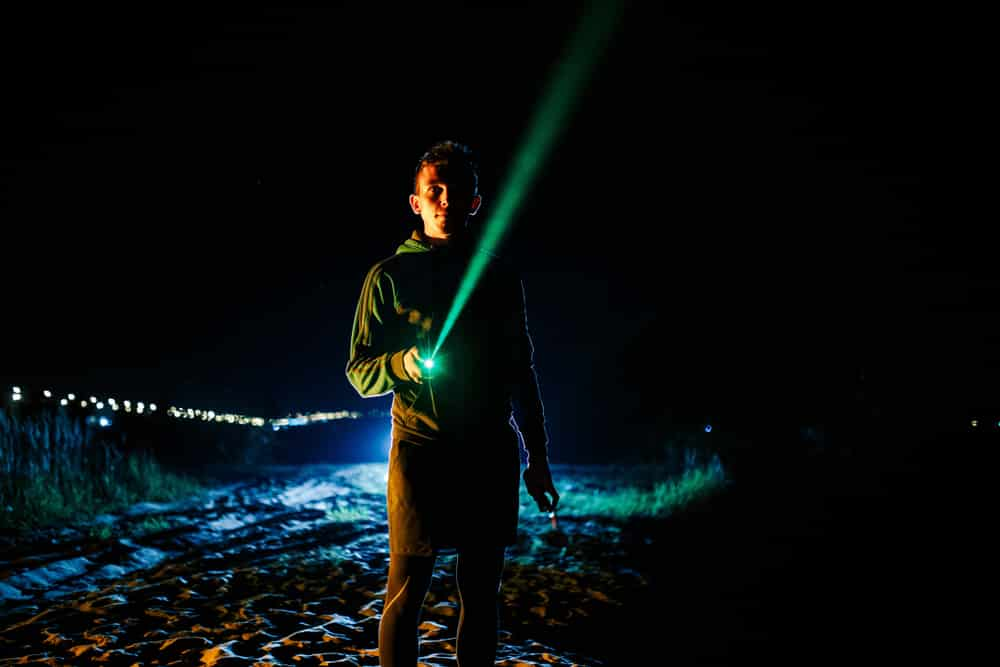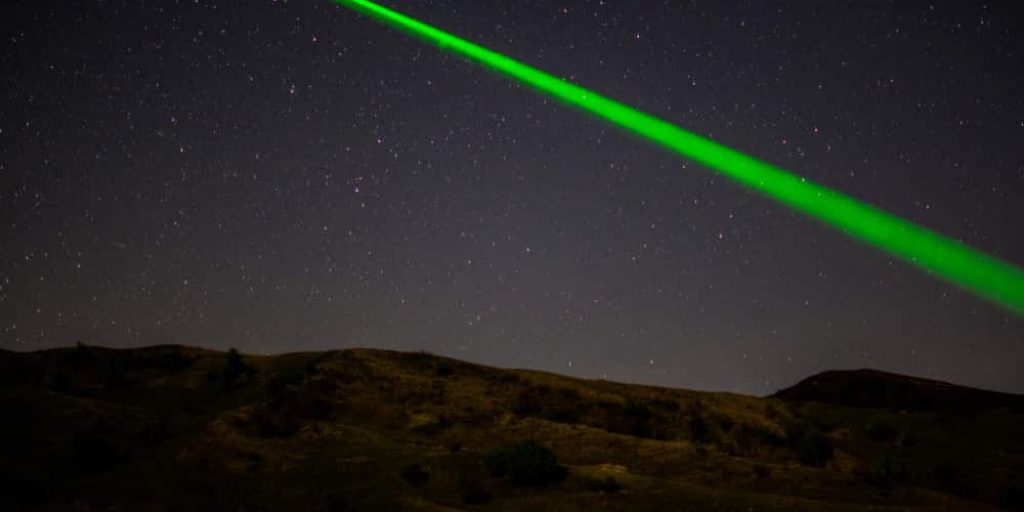Best Laser Pointers For Astronomy & Stargazing
Last Updated: 19 November 2020
Laser stands for “Light Amplification by Stimulated Emission of Radiation” and the first functioning laser was created in 1960 at Hughes Research Laboratory. Lasers were only intended for professional use when they came on the market in the 1980s. They quickly became popular, especially around 1986, when the famous Lazer Tag game was invented. Today, laser pointers come in all shapes and sizes, although the most popular version is shaped like a small pen and has an interchangeable head.
For astronomy, laser pointers have become a handy little accessory to use during your stargazing sessions. Their beam can help you point out objects in the night sky and in some situations, they can be used as a finder scope and align your telescope with your chosen telescopic target.
Disclaimer: If you choose to purchase an astronomy laser pointer through one of the links on this page, we may receive a small commission at no extra cost to you. Thank you for supporting our website.
Table of Contents

- Our top 3 stargazing laser pointers
- Pros & Cons of using a stargazing laser pointer
- Which colour is the best for stargazing?
- Choose the right laser power output
- Laser regulations to keep in mind
- How to use your astronomy laser pointer safely
- Tips on choosing a stargazing laser pointer
- Frequently Asked Questions
Our Top 3 Stargazing Laser Pointers
The MAYMOC green laser pointer is lightweight, easy to use and shock resistant thanks to its aluminum casing. Although it is marketed as a laser to be used for hunting and airsoft, its output power is less than 5 mW, which is ideal for your stargazing needs. The green beam can be seen up to 500 meters at night, which makes this laser pointer more than sufficient for astronomy purposes.
This compact green laser pointer won’t take up much space in your astronomy accessory bag. Its output power is 2 mW, which makes it a little safer to use for educational purposes such as star parties. A handy feature on this laser pointer is that you can adjust its accuracy thanks to two small screws that you can rotate with an Allen key. The free shipping is just the icing on the cake.
This device has a class IIIA laser, which puts it below 5 milliwatts of output power. The seller also offers a 6 month warranty when you purchase this green laser pointer. It comes with a rechargeable battery, which means you won’t have to buy batteries regularly if you are a heavy user. It’s simply a very useful laser pointer, easy to use and store, and handy for showing your loved one where the constellations are in the night sky.
Pros & Cons of using a stargazing laser pointer
There are some advantages to using a laser pointer to enhance your stargazing sessions. If you have a Dobsonian telescope, for example, you may be able to attach a laser pointer to the tube. The beam can help you roughly align your telescope with your celestial target.
If you want to teach your friends and family how to find the constellations or planets in the night sky, an astronomical pointer will make it fairly easy. If you’ve ever been to a star party, you must have seen how lasers can be such an accurate and effective way to point objects in the starry sky. In addition, handheld star pointers are often small and compact, taking up almost no space in your astronomy kit.
On the other hand, even though pointer lasers are small and cheap, they are still dangerous and must be handled with extreme caution. It is important that you check the regulations in your state or country before buying or using one.
What is the best laser beam color for stargazing?
Laser pointers are available in many different colours: Orange, Yellow, Green, Blue, Purple. If you use your laser pointer for astronomy, then any colour should do a fine job since you will be using it under a dark starry sky. That being said, each of those colours operates at different wavelengths and power output. A laser pointer that emits a green coloured beam is best since our eyes are more sensitive to the green region of the light spectrum. Green laser pointers seem to be the preferred colour for astronomy as they are mainly used during the night. They are quite bright without using too much power, while a red or blue laser would require much more power just to reach the same level of brightness.
They also tend to be cheaper than the other colours.

Choosing the right laser power output
There are many powerful green laser pointers on the market. It’s easy to think that the more power, the better. In our case, this is not necessarily true. For stargazing, you don’t need to buy a super-powered laser. You can find buying guides on the Internet that promote laser pointers used for hunting, and these lasers are far too powerful for astronomy. Star pointers are a great way to illuminate your astronomy sessions but we are not looking to start a firework with them… In fact, some of them are so powerful that their beam can be seen from the International Space Station!
In 2010, a study was conducted in which the output power of a laser pointer was tested and adjusted with the help of a crowd of 23 people. They found that the lowest power output where the laser beam was still clearly visible was between 1.4 and 5.6 milliwatts. And that was in an area heavily polluted by light.
Conclusion: Laser pointers with a power of more or less 5 mW are more than sufficient for astronomy. Do your wallet a favour and avoid the overpowered laser pointers.
Laser Regulations to keep in mind
As mentioned earlier, laser pointers can be fun to play with but they can also be very dangerous when not handled properly. Laser pointers are classified into different categories based on their potential for eye damage. For educational and astronomical purposes, it is recommended that you choose class 3a lasers.
Be sure to check the regulations in your country. If you are based in the UK, the sale of laser pointers with a power greater than 1 mW is illegal, but there are currently no restrictions on buying a laser pointer through import. More information on this page. In America, laser pointers are regulated by the FDA. Make sure your laser pen is approved for safe use.
How to use your astronomy laser pointer safely
Whether you’re teaching people at a star party or just sharing your love of the night sky with your loved ones, there are a few guidelines you can follow to make sure everyone stays safe. When using your star pointer, keep in mind the following key points:
- Be especially careful if children are present.
- Activate the laser beam only when the pointer is directed towards the sky.
- Do not point the beam at bushes or trees, as this may harm wildlife.
- When the star pointer is not in use, store it safely in your pocket.
- If you hear or see an aircraft in the sky, momentarily stop using the laser pointer until the sky is clear of any plane.
- Do not use your star pointer at all if your astronomy session takes place within 5 miles (8 kilometres) of an airport.
- Do not allow others to use or try your Green Laser Pointer as they may not know how to use it safely.
- When using the laser, it is best to have everyone close by to prevent someone from accidentally getting in the way of the light.
- Once the stargazing session is over, remove the batteries out of the pointer and store them out of the reach of children.
- If you are a star party participant, the use of the laser pointer may be limited to the organizers only. Be sure to check with your local astronomy society beforehand.
Tips on choosing a stargazing laser pointer
You may think that choosing a laser pointer is as trivial as buying a flashlight, but as we discussed before, these little things can be very powerful. Before you buy a laser pointer, consider the following criteria to make sure you get one that meets your astronomy needs:
- All amateur astronomers know the struggle: we have a lot of heavy things to carry. So choosing a small and compact astronomy pointer will not only save you space in your backpack but will also save you from carrying additional weight.
- Stargazing sessions usually last a few hours. So pay attention to the battery life, you don’t want your laser pointer to stop working after half an hour.
- Make sure that its power output is in line with your country’s regulations. A 5mW laser is bright enough to get the job done.
- Only purchase a laser pointer from a reputed supplier.
- Ensure that the product is either FDA approved in the US or CE approved in the UK (it indicates that the manufacturer has checked that these products meet EU health and safety requirements).
Frequently Asked Questions
Why do you need a laser pointer for astronomy?
You don’t necessarily need a laser pointer in order to stargaze and enjoy the night sky. However, they can be a handy little accessory to have.
What is the best laser pointer for astronomy?
A compact laser pointer with a green beam and an output power between 1 mW and 5 mW is more than sufficient.
How do you use a laser pointer for stargazing?
They are generally used to point out objects in the night sky, such as stars, planets, constellations, satellites and the International Space Station.
Welcome to StarLust.org
Hey! I’m Tom Urbain, the founder of StarLust.org. I have been obsessed with space from a very young age. When I’m not binge-watching space documentaries, movies or TV shows, I can be found in my backyard, carefully collimating my telescope… ready to observe the universe!




